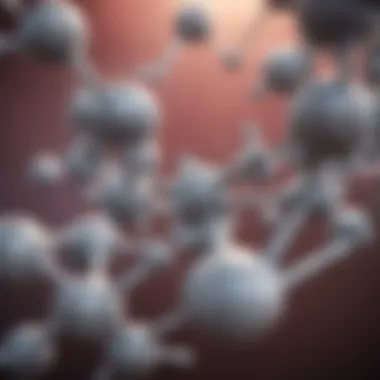Understanding Sucralose: Side Effects and Implications


Intro
Sucralose is an artificial sweetener that has gained significant popularity as an alternative to sugar. Marketed primarily because of its low-calorie content, sucralose is used in a variety of food and beverage products. Despite its widespread use, there are growing concerns about its effects on health, particularly with long-term consumption. This article aims to provide a comprehensive understanding of sucralose, focusing on its side effects, health implications, and current research findings.
Research Overview
Summary of Key Findings
Research indicates that sucralose can cause metabolic changes in some individuals. Although it is generally recognized as safe by authorities like the FDA, some studies have raised questions about its impact on gut health, glucose metabolism, and the overall microbiome. Notably, a study published in the Journal of Toxicology and Environmental Health found that daily sucralose intake might influence insulin levels and gut bacteria in certain populations.
Background and Context
Sucralose was discovered in 1976 and has since been incorporated into many food products, especially those marketed to health-conscious consumers. However, its long-term safety is under scrutiny, as not all regulatory bodies view its safety uniformly. Some researchers argue that more comprehensive studies are essential to fully understand the sweetener's effects, particularly as new evidence emerges regarding its interaction with the body.
Methodology
Experimental Design
Investigations into the effects of sucralose often employ randomized controlled trials. Participants are typically divided into groups, with one receiving sucralose while another group is given a placebo. This design helps to establish a clear comparison of effects stemming from sucralose consumption.
Data Collection Techniques
Data collected during these studies frequently include metabolic markers, such as glucose and insulin levels, alongside questionnaire responses about digestive symptoms. Additionally, microbiome analysis is sometimes performed to assess changes in gut flora following sucralose consumption. This dual approach helps to build a detailed picture of how sucralose may affect both metabolic and gastrointestinal functions.
"The implications of sucralose consumption extend beyond mere calorie counting, touching on critical aspects of metabolic health that warrant closer examination."
Understanding the full implications of sucralose is crucial for consumers making dietary choices. As continuing research sheds light on its effects, it is important to remain informed and vigilant regarding what we consume.
Prelude to Sucralose
Sucralose is a prominent artificial sweetener that has captivated the attention of many health-conscious individuals. Its relevance has grown particularly in the context of sugar substitutes, with discussions centering around its safety, health implications, and societal perceptions. This section aims to ground readers in the essentials of what sucralose is, setting the stage for deeper explorations in subsequent sections. Understanding sucralose is important not merely for consumers seeking alternatives to sugar but also for professionals in fields such as nutrition, health, and food science. The information on sucralose contributes to informed decision-making, relevant in discussions about metabolic health, diabetes management, and weight control, providing a layered perspective on its use.
What is Sucralose?
Sucralose is an artificial sweetener derived from sucrose, or table sugar. It undergoes a specific chlorination process to alter its structure, resulting in a compound that is approximately 600 times sweeter than sugar yet contains no calories. It is commonly found in various food products, leading many to embrace it as a sugar alternative without the caloric load associated with traditional sweeteners. Sucralose is heat-stable, allowing it to be used in baked goods and cooking, giving it an advantage over other sweeteners that may not withstand high temperatures.
Despite its popularity, the simplicity of sucralose as a technical compound belies the complexity of its effects on human physiology and consumption patterns.
History and Development
The history of sucralose can be traced back to the late 1970s when researchers at the University of Queen in Canada aimed to create a new sweetening agent. The first notable development occurred in 1976 when the compound was discovered. Unlike other artificial sweeteners that were often derived from amino acids, sucralose's unique method of synthesis set it apart.
In the years that followed, sucralose underwent rigorous testing to evaluate its safety for human consumption. The U.S. Food and Drug Administration approved its use in 1998 after extensive scrutiny, and it became widely available in many markets, including in products like drinks and processed foods. This approval marked a significant milestone, as it opened doors for sucralose to enter mainstream culinary applications.
Over the years, its acceptance has expanded internationally, leading to various regulatory endorsements. Countries across Europe, Asia, and Australia have embraced sucralose, leading to its proliferation in the global food landscape. The evolving use of sucralose continues to inspire both interest and skepticism, forming a crucial part of the conversations surrounding sugar alternatives today.
Mechanism of Action
Understanding the mechanism of action of sucralose is vital for comprehending its overall impact on health and wellness. This section explores how sucralose undergoes processing in the body and its metabolic pathways. A clear grasp of these processes can help clarify the consequences of its consumption, shedding light on debates surrounding adult and pediatric use.
How Sucralose is Processed
Sucralose is a chlorinated derivative of sucrose, made by replacing three hydroxyl groups in the sugar molecule with chlorine atoms. This modification prevents sucralose from being metabolized fully into energy by the body. Instead, sucralose' sweetness is detected on the taste buds, activating the sweet receptors without contributing calories.


When consumed, sucralose remains relatively intact as it travels through the digestive system. Unlike regular sugars, sucralose does not participate in the conventional metabolic pathways that lead to energy production. Research indicates that approximately 85% to 95% of ingested sucralose is excreted unchanged in the urine. Thus, its processing minimizes the risk of direct caloric intake, making it appealing for those managing their weight or blood sugar levels.
Absorption and Metabolism
The absorption of sucralose occurs primarily in the gastrointestinal tract. However, the absorption rate is low compared to other carbons. Once ingested, the bulk of sucralose bypasses systemic circulation. This characteristic is a significant point of study in understanding potential implications on health, especially concerning gut flora or blood glucose response.
There is evidence to suggest that sucralose may have minimal impact on insulin levels and glycemic control, which positions it as a favorable alternative for diabetics. Nevertheless, the long-term effects of this compound on metabolic processes remain under scrutiny.
As studies in nutrition science continue, various expert groups urge caution around its use. The topic of how sucralose interacts with the gut microbiota has become increasingly significant in discussions. The balance of good and bad bacteria in the gut can have a profound effect on overall health. Debates remain ongoing about whether low-calorie sweeteners like sucralose alter this delicate ecosystem adversely.
"Understanding how sucralose is absorbed and metabolized is crucial for evaluating its long-term health effects and safety."
As we unravel the complexities associated with sucralose, including its processing and absorption, it is essential to look at both beneficial and potentially harmful consequences. Further inquiry will aid in understanding its complete safety profile, eliciting informed choices from consumers and health professionals alike.
Commonly Reported Side Effects
Understanding the commonly reported side effects of sucralose is essential. It sheds light on health considerations and helps consumers make informed decisions regarding their dietary choices. While many people use sucralose without any issues, it's important to recognize that adverse reactions can occur. By examining these effects, one can understand the broader implications of sucralose consumption in everyday life.
Gastrointestinal Disturbances
Gastrointestinal disturbances are a frequent side effect associated with sucralose. These include symptoms such as bloating, gas, and diarrhea. Each symptom warrants individual attention, as they can significantly impact one’s quality of life. Understanding these disturbances helps consumers be prepared and responsive to potential reactions when using sucralose.
Bloating
Bloating is a common consequence that some experience after consuming sucralose. This phenomenon occurs when the stomach fills with gas or air, which may lead to discomfort and distension of the abdomen. This symptom is notable because it can impair daily activities and overall well-being.
One key characteristic of bloating related to sucralose is its variability; not everyone who consumes it will experience this effect. However, for those who do, it can result in considerable physical and social discomfort.
Advantages and Disadvantages: While bloating might be a minor inconvenience for some, it may become a more significant concern for others, especially when it impacts their eating habits or willingness to consume sucralose.
Gas
Gas production can be another common reaction to sucralose intake. This side effect can manifest as excessive flatulence or abdominal discomfort. Engaging with such a notable characteristic highlights the complex interactions between sucralose and the body’s digestive system.
Gas is often a result of fermentable substrates within the intestines. As sucralose alters the gut environment slightly, it can lead to increased gas production in sensitive individuals.
Advantages and Disadvantages: This symptom is generally benign, though it may influence social situations depending on its severity. Understanding the potential for gas production may help individuals manage their consumption more delicately, choosing when and how much to consume to mitigate discomfort.
Diarrhea
Diarrhea is another gastrointestinal issue that can arise following sucralose consumption, especially when taken in excessive quantities. This symptom reflects an inability of the intestines to absorb water effectively, leading to loose or watery stools.
The significant aspect of diarrhea in this context is that it can result from a chain reaction triggered by sucralose-induced changes in gut motility. This disruption can create an urgent need for restroom access and cause dehydration in severe cases.
Advantages and Disadvantages: While diarrhea is a relatively common response, it is critical to recognize that it can signify an underlying sensitivity or intolerance. For many, this may serve as a wake-up call to reconsider their intake of sucralose or any artificial sweeteners.
Effects on Gut Microbiota
The influence of sucralose on gut microbiota is a growing area of interest. Studies suggest that the consumption of artificial sweeteners may alter the composition and function of gut bacteria. These shifts could have implications for overall digestive health, weight management, and immune function.
Changes in gut microbiota can happen due to factors like altered pH levels or feeding patterns encouraged by sweeteners. Updated research in this area is vital for understanding how sucralose affects gut health.
Potential Allergic Reactions


Although rare, allergic reactions to sucralose have been reported. Symptoms can range from mild skin irritation to more severe respiratory issues. This unpredictability emphasizes the need for awareness among consumers, particularly those with existing food allergies.
Potential allergic responses highlight the importance of monitoring one’s individual reaction over time. Recognizing these side effects supports individuals in making more informed dietary choices concerning sucralose and similar sweeteners.
It is essential to consider individual variability in side effects experienced with sucralose, as not everyone will react in the same way. Understanding these factors can inform safer usage.
Long-Term Health Implications
Long-term health implications of sucralose consumption are critical to examine given the prevalence of this artificial sweetener in the modern diet. Understanding these implications informs consumers and health professionals and aids in making educated choices about dietary habits. While sucralose is recognized for its low-calorie content, there are rising concerns about its potential health effects over extended periods of use. This section discusses how sucralose may affect metabolism and its possible connections to obesity, both significant factors in overall health and wellness.
Impact on Metabolism
The impact of sucralose on metabolism is a subject of intense study. Initial research suggests that artificial sweeteners like sucralose may disrupt normal metabolic processes. Sucralose is not fully absorbed by the body, leading to a unique metabolic profile. When consumed, it does not elevate blood glucose levels effectively, unlike sugar. This has led some researchers to hypothesize that reliance on sweeteners like sucralose could impair the body's ability to regulate glucose and insulin sensitivity. Further investigation into this is required.
One of the key elements to consider is how the body responds to sweet tastes. Consuming sucralose might signal the body to expect calories, but the absence of those calories can confuse metabolic processes. As a result, there may be a compensatory mechanism that changes energy regulation, potentially leading to difficulties in weight management. Individuals may overcompensate by seeking out higher-calorie foods to satisfy their cravings.
Potential Links to Obesity
The link between sucralose consumption and obesity is complex and multifaceted. While sucralose itself is calorie-free, research indicates that it can influence eating behaviors and preferences in ways that promote excessive calorie intake. Studies suggest that regular consumption of sucralose may alter people’s taste preferences, steering them toward sweetness and leading to cravings for high-sugar foods.
"Research indicates that long-term intake of artificial sweeteners can result in increased appetite and desire for sweet foods, possibly contributing to obesity."
Additionally, the alteration of gut microbiota caused by artificial sweeteners, including sucralose, can impair metabolic functions. A healthy gut microbiome is essential for proper digestion and metabolism. Disruptions to the gut flora may influence fat storage and the way the body processes energy.
Factors to consider include:
- Changes in appetite regulation.
- The potential for increased intake of high-calorie foods.
- The importance of gut health in maintaining a healthy metabolism.
In summary, examining the long-term health implications of sucralose is essential for understanding its role in dietary habits and overall health. As more studies unfold, clarity will emerge regarding its effects on metabolism and the relationship to obesity. Consumers should remain cautious when incorporating sucralose into their diets and consider monitoring their overall dietary patterns.
Regulatory Perspectives
Understanding the regulatory landscape surrounding sucralose is crucial for both consumers and professionals. Regulatory perspectives provide insight into how governing bodies assess the safety and efficacy of food additives like sucralose. It sheds light on the processes that ensure public health is prioritized when such substances are approved for use. Knowledge of these perspectives helps to contextualize the ongoing debates about sucralose’s safety and its implications on health.
FDA Approval and Safety Assessments
The U.S. Food and Drug Administration (FDA) plays a vital role in the approval of food additives, including sucralose. First introduced to the market in 1998, sucralose underwent extensive testing before receiving Generally Recognized As Safe (GRAS) status. This status indicates that experts consider the substance safe when consumed as intended. The Safety assessment process includes a range of studies, focusing on:
- Toxicology: Evaluating potential toxic effects through various laboratory tests.
- Metabolism: Understanding how the body processes sucralose, including its absorption and excretion rates.
- Clinical Trials: Conducting human studies to assess behavioral and physiological impacts.
According to the FDA, sucralose is approximately 600 times sweeter than sugar yet passes through the body without being metabolized, which minimizes caloric intake. Still, safety assessments have prompted criticism from some health professionals who advocate for more transparency in the approval process. It is important to note that while FDA clearance offers a level of trust, it does not absolve the necessity for ongoing research and consumer awareness about potential long-term effects.
Global Regulations and Approved Uses
The regulatory framework around sucralose varies around the world. Many countries adhere to guidelines set by the Codex Alimentarius Commission, which offers parameters for food safety standards globally. For instance, in Europe, the European Food Safety Authority (EFSA) conducts thorough evaluations similar to those of the FDA. In contrast, regions like Asia may have different tolerances and uses which can lead to varying degrees of public acceptance.
Global regulations also dictate the specific uses of sucralose. It is commonly permitted in:
- Beverages: Including soft drinks, diet drinks, and flavored waters.
- Processed Foods: Such as desserts, sauces and snacks designed for low-calorie consumption.
- Pharmaceuticals: Used as a sweetener in medications and vitamins.
Understanding these regulatory nuances is essential for consumers who wish to make informed decisions about their dietary choices involving sucralose.
These differences in regulations reflect varying levels of public concern, scientific input, and health objectives across countries. The careful scrutiny by different regulatory bodies underscores the need for continuous research and more comprehensive safety evaluations, ensuring that consumers are well-informed about what they consume.


Controversies and Debates
The discussion surrounding sucralose has generated notable controversies and debates, especially within the health community and among consumers. This segment addresses those concerns, highlights the criticisms from health professionals, examines the prevalent misinformation in public perception, and seeks to clarify the implications of this ongoing dialogue. Understanding these controversies is crucial, as they shed light on the broader implications of sucralose consumption and how it is perceived in society.
Criticism from Health Professionals
Many health professionals have expressed concerns about the safety of sucralose. Critics argue that while sucralose is deemed safe by regulatory bodies, this endorsement does not necessarily guarantee that it is harmless for all populations. Some studies suggest that sucralose may have adverse effects on metabolic health, gut microbiota, and insulin response.
A significant point of contention is the term "safe for consumption." This often leads to misinterpretations by the public. Notably, some research indicates changes in gut bacteria when sucralose is consumed.
Health professionals often advocate for a thorough and ongoing examination of sucralose's long-term impacts. They highlight that, even though regulatory agencies like the FDA have approved it, new evidence can emerge that challenges prior assessments. This proactive approach is crucial to ensure public health.
Public Perception and Misinformation
Public perception of sucralose is influenced significantly by misinformation and the general skepticism surrounding artificial sweeteners. Misunderstandings about sucralose often arise from anecdotal experiences and sensationalized media reporting. These narratives can distort the factual information available about sucralose's safety and efficacy.
A common misconception is that all artificial sweeteners are harmful and lead to negative health outcomes—a sweeping generalization that does not apply universally. Social media and various platforms can amplify these misconceptions, leading to confusion. Furthermore, discussions in forums such as Reddit often lack scientific rigor and can propagate fears without evidence.
Moreover, many individuals remain unaware of the differences between various non-nutritive sweeteners. This can lead to misguided avoidance of products that contain sucralose simply because they fear "artificial" additives.
In summary, the controversies and debates surrounding sucralose encapsulate a critical conversation in public health. They highlight the necessity for continued research and open dialogues between health professionals and the public. As consumers strive for better choices, a well-informed perspective on sucralose can facilitate safer and healthier dietary decisions.
Future Research Directions
Research in the field of sucralose continues to evolve. The current body of literature presents a range of insights, yet many questions persist. Investigating the long-term health effects of sucralose is particularly essential, especially as consumption rises globally. This section focuses on emerging studies and the potential areas that require further exploration. Addressing these areas can lead to a deeper understanding of sucralose and its implications for health and wellness.
Emerging Studies and Findings
Recent studies have indicated that sucralose might affect not only sweetness perception but also metabolic processes. For instance, some research suggests that sucralose could impact insulin sensitivity, a crucial factor in metabolic health. The role of sucralose in weight management is another focus of ongoing research. Interestingly, findings have shown mixed results, with some individuals experiencing weight gain potentially linked to the use of artificial sweeteners like sucralose.
Another study conducted on animals revealed changes in gut microbiota after sucralose exposure. This raises questions about how frequent consumption could affect human gut health. This supplementation of knowledge is vital for drawing conclusions about the feasibility of sucralose as a safe long-term sugar substitute.
In summary, these emerging studies indicate a need for rigorous and comprehensive evaluation. The findings thus far highlight potential metabolic effects, but more human trials are necessary to clarify these relationships.
Potential Areas for Investigation
Several specific areas should be prioritized for further study concerning sucralose:
- Long-Term Safety: More longitudinal studies are necessary to understand the cumulative effects of sucralose consumption over years.
- Metabolism and Appetite: Exploring the relationship between sucralose, metabolism, and appetite can provide insights into its role in weight management and overall health.
- Microbiome Studies: Investigating the effects of sucralose on gut microbiota and its subsequent impact on overall health deserves more attention.
- Individual Variability: Research could focus on how genetic factors influence individual responses to sucralose and its perceived sweetness.
- Interactions with Other Substances: Understanding how sucralose interacts with other food components can shed light on its overall impact on health.
Conducting research in these areas will not only help fill the knowledge gaps but also assist consumers in making informed decisions regarding sucralose use in their diets.
Ending
Understanding sucralose and its potential side effects is crucial for consumers who strive to make informed dietary choices. This article offers a detailed examination of sucralose, shedding light on various aspects including its mechanism of action, health implications, and regulatory frameworks. Recognizing the side effects associated with sucralose can empower individuals to evaluate its use in their diets critically.
The summarized key points develop a narrative urging consumers to assess not only the immediate benefits of using sucralose as a sugar substitute, but also its long-term health implications. As the prevalence of artificial sweeteners increases, the enough scrutiny surrounding their consumption becomes necessary to safeguard public health. Furthermore, considering existing controversies and ongoing research about sucralose, it appears essential for consumers to remain informed.
"Informed choices can lead to healthier lifestyles, particularly when it comes to popular dietary products like sucralose."
Summary of Key Points
- Nature of Sucralose
Sucralose is an artificial sweetener derived from sugar, often marketed as a no-calorie alternative. Its ability to be significantly sweeter than sugar has increased its usage in food products. - Health Effects
While generally regarded as safe by regulatory agencies, some studies have linked sucralose consumption to gastrointestinal issues, alterations in gut microbiota, and potential metabolic consequences. - Controversies
The debate about sucralose includes varying viewpoints from health professionals and the public, primarily influenced by misinformation and inconsistent data on long-term effects. - Future Research
Ongoing studies may provide better insight into the metabolic impacts and broader health implications of long-term sucralose intake.
Considerations for Consumers
When incorporating sucralose into your diet, consider the following:
- Personal Sensitivity: Some individuals may experience digestive issues even at low doses of sucralose. Monitoring your own body's response is vital.
- Long-Term Effects: Awareness of emerging research is important. Be cautious about relying too heavily on artificial sweeteners without understanding their implications fully.
- Balanced Diet: It is essential to view sucralose as part of a broader dietary context. You should not depend on such sweeteners for weight management or overall health.
- Check Labels: Always read food labels to understand the contents and make informed choices regarding sucralose and other additives.
Thus, while sucralose has its benefits, it is imperative for consumers to explore these considerations carefully and remain educated about its use.







